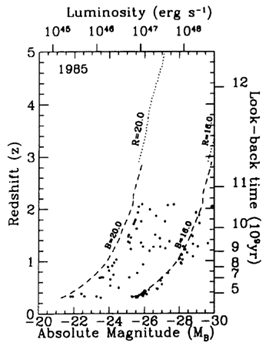

The problems inherent in the detection of significant numbers of quasars have long since been overcome. The fourth Hewitt and Burbidge catalog (Hewitt and Burbidge 1993) lists positions, magnitudes and redshifts for 7315 quasars. This and the earlier versions of the catalog (Burbidge, Crowne and Smith 1977, Hewitt and Burbidge 1980, 1987), together with the catalog of Véron-Cetty and Véron (1991) and references therein, have proven to be an invaluable resource, but by their nature consist of an extraordinarily heterogeneous mix. Focusing more particularly on samples suitable for statistical analyses of the quasar population, Boyle (1993; Figure 1) has provided a graphic illustration of the pace of change. He plots absolute magnitude versus redshift to illustrate the growth of the number of objects published in ``well-defined'' surveys for quasars in the optical passbands. A version of Boyle's plot is shown in Figure 1. The number of objects in such samples has grown exponentially in recent years, with an attendant significant increase in our knowledge of how the quasar population evolves with cosmic time. However, given the large numbers of quasars now cataloged, the lack of even qualitative answers to basic questions, such as ``Do the spectral energy distributions of quasars evolve as a function of cosmic time?'' or, ``Does the space density of quasars decline at redshifts z > 4?'' appears surprising.

| 
|
| Figure 1. Absolute magnitude vs. redshift plots showing optically selected quasars identified in well-defined sample prior to 1986 (left) and 1992 June (right). Look-back time and approximate bolometric luminosities are also indicated for a cosmology with H0 = 50 km s-1 Mpc-1 and q0 = 0.5. The locus corresponding to quasars with apparent magnitudes mB = 16 and mB = 20 are also shown. The growth in the number of quasars has been spectacular, particularly for redshifts z > 2.2, with some 2000 quasars plotted in the 1992 panel. Details of the quasar samples included can be found in Table 1 of Boyle (1993). |
In this review we attempt to provide an answer to the question ``Given such a large number of cataloged quasars, why is our knowledge so limited in many areas?'' The reasons are in part due to fundamental limitations imposed by the nature of the problem, but of equal or greater importance is the poor quality of much of the available data, and the lack of a quantitative understanding of the effectiveness (or otherwise) of quasar surveys themselves. Our approach is very different from one where an exhaustive list of recent and ongoing surveys is compiled and the techniques they employ are described in detail. We have chosen not to proceed in this fashion for two reasons: first, the published proceedings of two workshops, the first held in Tucson in January 1988 (Osmer et al. 1988), the second in Victoria in June 1991 (Crampton 1991), provide comprehensive snapshots of ongoing work in the field; second, several recent reviews include extensive discussions of techniques and give references to original work. Instead, while mentioning some recent results, this paper attempts to highlight the problems that must be overcome in order that the scientific goal of a survey can be achieved.
We direct readers requiring a more conventional summary of the status of quasar surveys to the abovementioned workshop proceedings and to a number of excellent recent reviews of the behavior of the quasar population. Specifically, the presently-accepted picture of the evolution of the luminosity function is described by Boyle (1993) and Hartwick and Schade (1990), with the latter paper concentrating on samples defined in the optical. Warren and Hewett (1992) concentrate on the evolutionary behavior of quasars, particularly for redshifts z > 2, while discussions of their spatial clustering properties can be found in Boyle (1991) and Hartwick and Schade (1990).
This review is organized as follows: Section 2 summarizes the intrinsic properties of quasars which bear upon the probability of their inclusion in a specific survey, i.e., their luminosity, redshift and spectral energy distribution. In Section 3, we present a brief discussion of the fundamentals of quasar surveys at all wavelengths, with particular attention paid to methods for maintaining a high efficiency of detection. Three generic types of surveys are defined in Section 4, in order of increasing complexity. Each type allows the achievement of a specific class of scientific goals, but the most interesting results will come from surveys for which one can quantitatively estimate the probability of a specific quasar's inclusion. The necessary components of such a calculation and its concomitant difficulties are detailed in Section 5 along with a critical discussion of how such an accurate assessment of the detection probability bears on the issue of ``completeness.'' Various practicalities and caveats to which attention must be paid during the design of a successful survey are discussed in Section 6. A summary of the current status and future prospects of efforts to understand the quasar luminosity function is presented in Section 7, followed by a brief summary in Section 8.